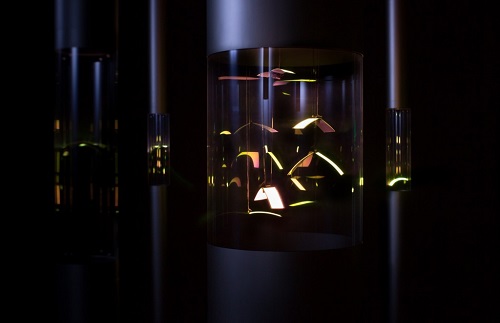Takram design engineering (takram) have designed and developed an OLED (Organic Electro-Luminescence) installation titled “Cradle of Light” to be presented at Light and Building 2014, the world’s largest lighting and architecture exhibition (Frankfurt Germany from 30th March 2014). The installation demonstrate the compelling performance of Konica Minolta’s OLED Lighting Panel, the world’s thinnest* and world’s first* color tunable function for flexible type.
 |
|
“Cradle of Light” showcases Konica Minolta's newest OLED lighting. |
OLED Lighting is considered as the next generation of lighting technology after LED as it opens up a whole world of possibilities: better durability with broader temperature range and its flexibility. The project started with Konica Minolta’s presentation of “Luminous Wings” at Lighting Fair (March 2013, Tokyo) when Takram collaborated as art director to illustrate its advanced characteristics of thinness, lightness and its flexibility. Followed by “Luminous Wings”, this is a second chapter designed under the theme of “ ‘Luminous Wings’ ~ Chapter Two: Cradle of Light” a place where OLED lighting is engendered, incubated and play the principal role in a new culture of light. Takram have designed and developed 3 types of demonstration model, designed the installation space, and directed the sound, all in an effort to illustrate the potential of advanced OLED lighting.
Overview of Demonstration Models at the Show
Irodori
The world’s first flexible-type OLED lighting panels, with color tunable function, are designed in layers like peacock feathers. The demonstration model rotates slowly to show its expressive nuance through the changing colors. As the panels adopt different layer construction from that of displays, the color-tunable panels emit light evenly over the complete surface.
 |
|
Flexible-type OLED lighting panels with color tunable capability. |
Ibuki
The world’s thinnest, 70-micron OLED lighting panel floats in the air, fanned by the wind. As if it were a feather falling from the sky, the demonstration model sways in the wind and dances lightly.
 |
|
World's thinnest OLED light source is so light it can float in the air. |
Habataki
The Habataki, showcased at the “Lighting Fair” in March 2013, has gone through further evolution. The flexible panel will give a strong impression of the moment of a fledged bird’s leaving the nest.
 |
|
Flexible panels, the Habataki, shown at Light+Building 2014. |
Space Design Concept
“Cradle of Life” is another name for our ancient world where diverse life forms emerged and human beings took their first step toward evolution. As “Life” was engendered by the primordial world, this space gives birth to and nurture new forms of lighting. This is a “Cradle of Light” in which diverse forms of OLED emerge and are cultivated as next generation of lighting.















